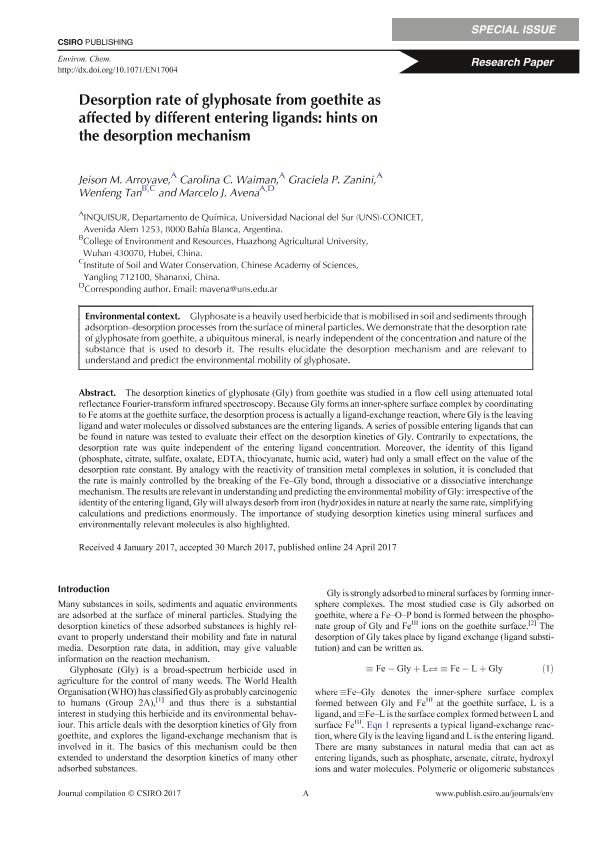Artículo
Desorption rate of glyphosate from goethite as affected by different entering ligands: Hints on the desorption mechanism
Arroyave Rodriguez, Jeison Manuel ; Waiman, Carolina Vanesa
; Waiman, Carolina Vanesa ; Zanini, Graciela Pilar
; Zanini, Graciela Pilar ; Tan, Wenfeng; Avena, Marcelo Javier
; Tan, Wenfeng; Avena, Marcelo Javier
 ; Waiman, Carolina Vanesa
; Waiman, Carolina Vanesa ; Zanini, Graciela Pilar
; Zanini, Graciela Pilar ; Tan, Wenfeng; Avena, Marcelo Javier
; Tan, Wenfeng; Avena, Marcelo Javier
Fecha de publicación:
24/04/2017
Editorial:
Csiro Publishing
Revista:
Environmental Chemistry
ISSN:
1448-2517
Idioma:
Inglés
Tipo de recurso:
Artículo publicado
Clasificación temática:
Resumen
The desorption kinetics of glyphosate (Gly) from goethite was studied in a flow cell using attenuated total reflectance Fourier-transform infrared spectroscopy. Because Gly forms an inner-sphere surface complex by coordinating to Fe atoms at the goethite surface, the desorption process is actually a ligand-exchange reaction, where Gly is the leaving ligand and water molecules or dissolved substances are the entering ligands. A series of possible entering ligands that can be found in nature was tested to evaluate their effect on the desorption kinetics of Gly. Contrarily to expectations, the desorption rate was quite independent of the entering ligand concentration. Moreover, the identity of this ligand (phosphate, citrate, sulfate, oxalate, EDTA, thiocyanate, humic acid, water) had only a small effect on the value of the desorption rate constant. By analogy with the reactivity of transition metal complexes in solution, it is concluded that the rate is mainly controlled by the breaking of the Fe–Gly bond, through a dissociative or a dissociative interchange mechanism. The results are relevant in understanding and predicting the environmental mobility of Gly: irrespective of the identity of the entering ligand, Gly will always desorb from iron (hydr)oxides in nature at nearly the same rate, simplifying calculations and predictions enormously. The importance of studying desorption kinetics using mineral surfaces and environmentally relevant molecules is also highlighted.
Palabras clave:
Adsorption
,
Glyphosate
,
Goethite
,
Desorption
Archivos asociados
Licencia
Identificadores
Colecciones
Articulos(INQUISUR)
Articulos de INST.DE QUIMICA DEL SUR
Articulos de INST.DE QUIMICA DEL SUR
Citación
Arroyave Rodriguez, Jeison Manuel; Waiman, Carolina Vanesa; Zanini, Graciela Pilar; Tan, Wenfeng; Avena, Marcelo Javier; Desorption rate of glyphosate from goethite as affected by different entering ligands: Hints on the desorption mechanism; Csiro Publishing; Environmental Chemistry; 14; 5; 24-4-2017; 288-294
Compartir
Altmétricas



